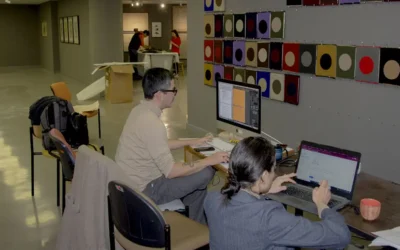Teens, Smartphones, and the Myth of What Museum Engagement Looks Like

Rachael Cristine Woody
The first time I saw the photograph was December 2014. The photograph depicted a group of teens sitting on a bench in a grand museum hall, heads bowed, looking at their smartphones. It made the rounds with many (including museum professionals) expressing outrage and disappointment that the teens would act so disrespectfully while in the museum.
The general consternation seemed to center around this critical question: “Why were these teens on their phones instead of looking at and engaging with the art on display?”
The truth about that photograph
The photograph was taken at the Rijksmuseum (Amsterdam) in front of one of its most famous pieces by Rembrandt: The Night Watch. In what is now common behavior in the age of social media, the image was judged without context. The truth behind the image is the following: these students had just finished listening to a lecture from an expert while viewing the art and were photographed completing an assignment (post-lecture) using the Rijksmuseum’s app.
Different photograph, same problems
A similar but different photograph with different teens at a different museum (Metropolitan Museum of Art) began circulating in early December 2019 – by Bette Midler, no less. Having forgotten the lesson we learned in 2014, or perhaps never hearing about the 2014 incident (or when it surfaced again in 2016), the pattern of outrage repeated itself with the same assertion made: these teens are being disrespectful and are completely missing the point of being at the museum. Fortunately, the social media community was quick to correct Midler stating the teens were using the Met’s app to research the Aegina Visited by Jupiter, and provided further criticism that Midler never should have shared a photograph of underaged youth without their consent, let alone shame them.
There are several things wrong with this repeating social media trope
This repeating scenario of young people being photographed and shamed for engaging with museum content differently has several things wrong with it:
- We should not be photographing or sharing images of anyone, and especially not youth, without their consent.
- We should not be shaming anyone for actions that are hurting literally no one.
- We need to acknowledge that people have preferred methods of learning and engagement when at museums. Some may want to gaze at the object, some prefer to read all the information they can find on it (from panels, pamphlets, museum apps, and the internet), and others may wish to simply experience the space without particular attention devoted to any one object.
- Museums are not just walls and physical objects—considerable effort has been made by many museums to provide supplemental enrichment content online to increase avenues of engagement through their website, collections management system, and smartphone apps.
- Many have sensory-induced discomfort and live with mental and physical health issues that are exacerbated by sensory overload. This means that in order to enjoy museum objects, they can’t stand with a group to view it or to read the plaque, but they can participate in the enjoyment with the help of technology.
The myth of what museum engagement looks like
Museums have evolved. The intentional use of technology to help supplement the museum experience is a regular part of our methodology as museum professions. Creating the exhibit narrative, choosing how to display the objects, and consciously constructing the exhibit experience to meet the needs of a variety of museum visitors are all a part of the museum exhibit creation process. Technology is a regular feature of the physical exhibit with the use of touchscreens, augmented and virtual reality, overlay projections, etc. And it’s also an opportunity for museums to provide supplemental digital exhibit experiences through websites, apps, and the collections management system. The traditional image of museum visitors gazing at art is only one of many ways a museum visitor can meaningfully engage with exhibits. Both museum professionals and museum visitors need to dismiss the myth that there’s only one correct way to engage with museum exhibits. There’s no right way to enjoy an exhibit, so let’s stop shaming those who are in museum spaces, engaging with exhibits in the way they choose.

Rachael Cristine Woody
Consultant, author, and blogger Rachael Cristine Woody advises on museum strategies, collections management, grant writing and the future of museums for a wide variety of clients. Join us for “How to Make the Case for a (Better) Museum CMS”, the first webinar in Rachael’s new series. For this month only, watch this webinar at your convenience—anywhere, at any time, on-demand. Watch now!
Similar Posts
How to Incorporate Interns in Museum CMS Projects: Data Cleanup and Refinement
A museum expert details how interns can be successfully included in museum CMS projects at the data cleanup and refinement stage.
How to Incorporate Interns in Museum CMS Projects: Data Creation
A museum expert details how interns can be successfully included in museum CMS projects at the data creation stage.
How to Incorporate Interns in Museum CMS Projects: Data Capture
A museum expert highlights how interns can be included in museum CMS projects at the data capture stage
How to Incorporate Interns in Museum CMS Projects
A museum expert highlights how interns can be included in museum CMS projects with three project ideas.
Hosting service
Enjoy all of the benefits of your Lucidea solution with secure, reliable, stress free hosting
Programs & incentives
No matter your size or budget, we’ve got you covered, today and tomorrow




Leave a Comment
Comments are reviewed and must adhere to our comments policy.
0 Comments